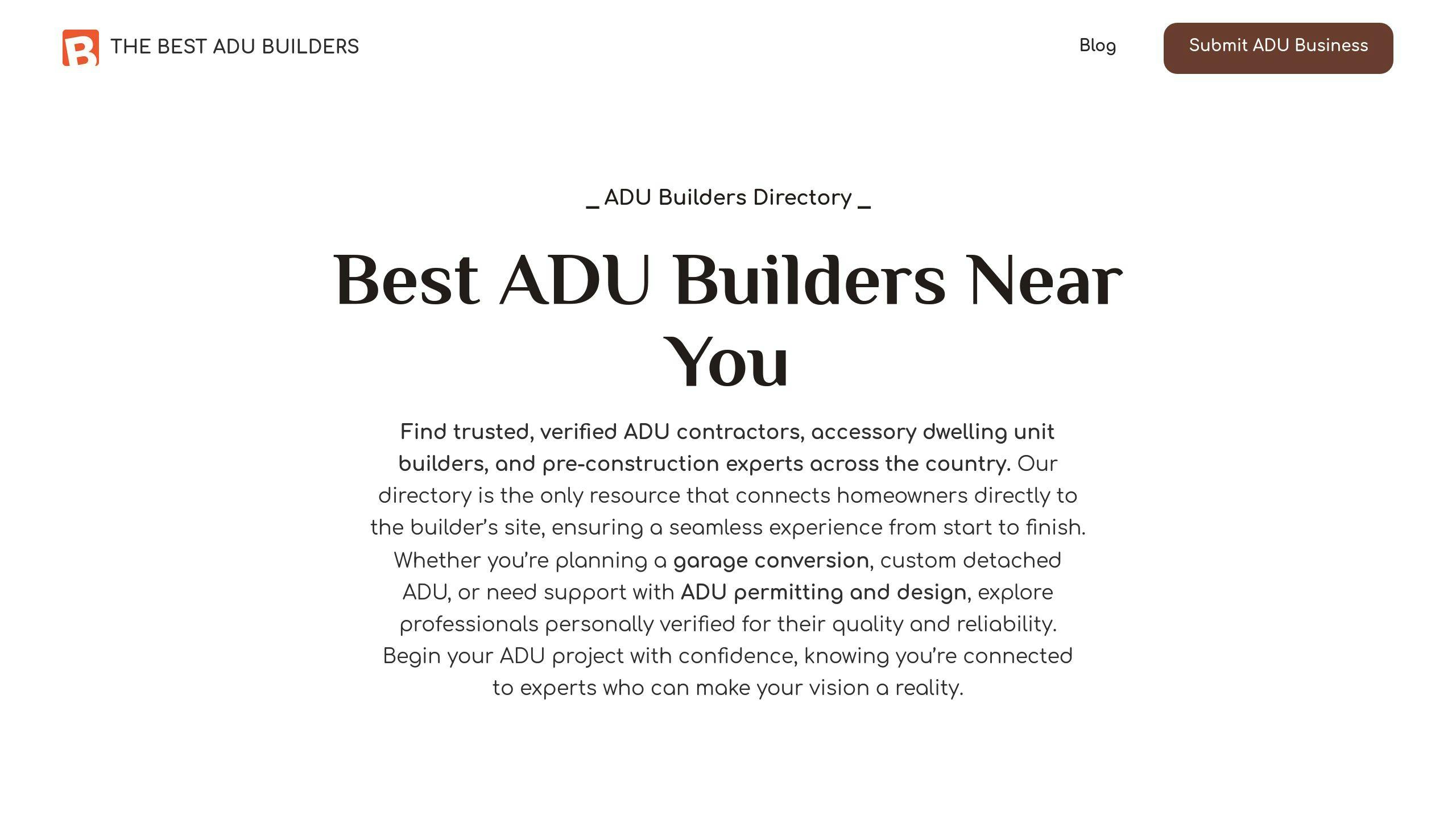Building an ADU isn't easy, but understanding the process helps. Here's a quick overview of the main phases:
- Planning and feasibility (1-4 weeks)
- Design and engineering (12 weeks)
- Permitting (16-24 weeks)
- Construction (16-24 weeks)
- Final inspections and occupancy (1-2 weeks)
| Phase | Time | Key Activities |
|---|---|---|
| Planning | 1-4 weeks | Property check, budget setting, builder selection |
| Design | 12 weeks | Sketching ideas, detailing plans, engineering |
| Permitting | 16-24 weeks | Paperwork, city review, adjustments |
| Construction | 16-24 weeks | Site prep, building, utility hookups, finishing |
| Final Steps | 1-2 weeks | Safety checks, final approval, move-in clearance |
Remember: These timelines can vary based on your location, project complexity, and local rules. In some places like LA, streamlined ADU regulations might speed things up.
Understanding these milestones helps you:
- Set realistic deadlines and budgets
- Work effectively with professionals
- Anticipate potential issues
- Make informed decisions throughout the process
Let's dive into each phase to set you up for ADU success.
Related video from YouTube
1. Getting Started
Starting an ADU project is exciting, but it needs careful planning. Let's look at the key first steps to get your ADU journey off to a good start.
Check Your Property
First, make sure your property can actually have an ADU:
- Look up local zoning laws. Some states like California are ADU-friendly, but rules change by city.
- Walk your land. Where could the ADU go? Think about things like setbacks and where utilities are.
- Know the size limits. In California, for example, detached ADUs can be up to 1,200 square feet. Attached ones? Only up to half the size of your main house.
Set Your Budget
Money matters. Here's a rough idea of what you might spend:
| What | How Much |
|---|---|
| Design and Planning | $6,000 - $14,000 |
| City Fees | $3,000 - $11,000 |
| Building (per sq ft) | $175 - $350 |
| Finishing (per sq ft) | $50 - $100 |
These are just averages. Your actual costs might be different. For instance, in Temecula, California, a small JADU might cost about $182,000. A bigger ADU? That could be over $540,000.
Pick Your Builder
Choosing the right builder is key. Here's what to do:
- Find builders who specialize in ADUs in your area.
- Check their credentials and past work.
- Read what other people say about them.
- Get quotes from a few different builders.
"A good builder can make your ADU dream come true. Look for someone with experience and a history of finishing ADUs successfully." - Leah Kabli, Founder of TheBestADUBuilders.com
First Design Meeting
Your first meeting with the designer sets the stage for everything. Here's how to prepare:
- Bring pictures of ADUs you like
- Know your budget
- Think about how you'll use the ADU
- Ask about ways to save energy (and money)
Project Checklist
Before you go any further, make sure you've done these things:
- [ ] Checked if ADUs are allowed in your area
- [ ] Looked at your property to see if it works for an ADU
- [ ] Set a budget you can stick to
- [ ] Found a builder you trust
- [ ] Thought about what you want your ADU to look like
- [ ] Learned about the permits you'll need
2. Design Steps
Designing your ADU is a big deal. It's the blueprint for your entire project. Let's break it down into manageable chunks.
Building Plans
First up: creating detailed building plans. This process usually involves five stages:
- Site Measurement
- Schematic Design
- Design Development
- Construction Documents
- Permit Submission
"Hire a draftsman or architect who knows ADUs inside and out, especially in your city. It's a game-changer." - Experienced General Contractor
Here's a real-world win: In Los Angeles, one homeowner's plans got the green light in just 30 days, thanks to their ADU-savvy architect.
Property Layout
Your ADU needs to play by the rules. That means following local zoning laws and building codes. Keep an eye on:
- How far it needs to be from property lines
- How big it can be
- How tall it can be
- Parking rules
For example, in California, you can build a detached ADU up to 1,200 square feet. But if you're attaching it to your main house, you're limited to 50% of the house's size.
Pick Materials
Choosing materials isn't just about looks - it's about your wallet too. Here's a rough breakdown:
| Component | Slice of the Pie |
|---|---|
| Materials | 45-50% |
| Labor | 40% |
| Pro Fees | 20-30% |
Think about durability, energy efficiency, and your local weather when picking materials. Good insulation, for instance, can save you money on energy bills down the road.
Final Costs
Time to get real about numbers. Here's what different types of ADUs typically cost:
| ADU Type | Price Tag |
|---|---|
| Basement makeover | $60,000–$150,000 |
| Garage transformation | $60,000–$150,000 |
| New attached build | $100,000–$216,000 |
| Above-garage build | $128,000–$225,000 |
| New detached build | $110,000–$285,000 |
Remember, these are ballpark figures. Your actual costs might be different based on where you live, how big your ADU is, and what design choices you make.
Design Check
Before you dive in, double-check everything. Make sure your design:
- Fits within size limits
- Uses approved exterior materials
- Includes all required safety features
"Always call the inspector before you cover up any work. It's a simple step that can save you big headaches." - Leah Kabli, Founder of TheBestADUBuilders.com
3. Getting Permits
Getting permits for your ADU isn't a walk in the park, but it's a must-do. Here's how to tackle it:
Prepare Papers
First things first: gather these docs:
- ADU Permit Application Form (filled out)
- Proof you own the property
- Site plans (current and future)
- Detailed construction plans
- Tree permit (if you're axing protected trees)
"Get your docs ready before applying. It can shave weeks off the process." - Leah Kabli, TheBestADUBuilders.com
What to Submit
Your local planning folks need:
| Document | What It Is |
|---|---|
| Application Form | The whole shebang, filled out right |
| Site Plans | Your property now, and with the ADU |
| Construction Plans | Blueprints, floor plans, the works |
| Ownership Proof | Legal stuff showing it's your place |
| Fee Payment | Permit fees (usually $2,000 - $10,000) |
City Review
Once you've handed it all in, here's what happens:
1. Initial look-see (1-2 weeks)
2. Department green lights (time varies)
3. Fixes and do-overs (if needed)
In L.A., things move faster. Florentine Christian from Sidekick Homes says, "We submit to LADBS, and in a few weeks, we get feedback and a list of clearances we need."
Get Your Permits
If all's good:
1. Pay up (any leftover fees)
2. Snag your approved permits
3. Set up erosion control (they'll tell you what)
4. Book your inspections
Heads up: In L.A., most ADU permits take 4-6 months. But if you're near the coast or in a special zone, it might take longer.
Rules Check
Before you start digging:
- Make sure you're following zoning rules
- Check you're up to code
- Think about your impact on the environment
- Get geohazard clearance (if you need it)
"Always ring the inspector before you cover anything up. It's a small step that can save you big time." - Avi Levi, Levi Construction
sbb-itb-4e754d1
4. Building Your ADU
You've got your permits. Now it's time to build. Let's break down the process:
Prepare the Land
First, get your site ready:
- Clear the area
- Grade the land
- Mark utility lines
"Good site prep saves you money. Don't cut corners here." - Leah Kabli, TheBestADUBuilders.com
Build Foundation
Your ADU needs a solid base:
- Excavate
- Install footings
- Pour concrete
For an 800 sq ft ADU, this takes about 1-2 weeks.
Frame and Build
Now your ADU takes shape:
- Put up wall frames
- Install roof trusses
- Add sheathing
| Task | Time |
|---|---|
| Wall framing | 3-5 days |
| Roof framing | 2-3 days |
| Sheathing | 2-3 days |
Add Utilities
Time to wire up your ADU:
- Rough-in plumbing
- Install electrical
- Set up HVAC
This takes about 2-3 weeks. Work closely with your contractor here.
Finish Work
The final push:
- Insulation and drywall
- Flooring
- Cabinets and countertops
- Paint
- Fixtures and appliances
This takes 4-6 weeks, depending on your design.
"Build for energy efficiency. It costs more now but saves you later." - Avi Levi, Levi Construction
Don't forget: You'll need inspections throughout. Your contractor should handle this, but stay in the loop.
Building an ADU is a big job. But with a good team and prep, it can go smoothly. Keep talking to your contractor, be ready for surprises, and soon you'll have your new space.
5. Project Completion
You're almost there! Let's wrap up your ADU project and make it official.
Safety Checks
Time for the pros to give your ADU a thorough inspection:
- Book your final inspection with the city
- Test all systems (electrical, plumbing, HVAC)
- Double-check everything matches your approved plans
"Final inspections usually take 2-4 hours. They cover everything from structure to safety features." - Leah Kabli, TheBestADUBuilders.com
Plan ahead: Prep at least two weeks before the inspection. It'll save you time and stress later.
Final Approval
Pass the inspection, and you'll get your Certificate of Occupancy (CO). Here's what you need to know:
Most cities issue the CO within two business days after you pass. Some places, like San Diego, don't give COs for single units or duplexes. Need to move in ASAP? You can ask for a Temporary CO, but it'll cost you about $410.
Last Review
Before you celebrate, do one last walkthrough:
| Area | What to Check |
|---|---|
| Outside | Visible address numbers, paint job, no exposed wires |
| Inside | All fixtures installed, working appliances |
| Systems | Every outlet, switch, and faucet |
| Paperwork | All permits closed, fees paid |
Get Your Papers
Gather these important documents:
- Certificate of Occupancy (or Temporary CO)
- All closed permits
- Final inspection reports
- Warranty info for appliances and systems
Keep these safe - you might need them if you sell or refinance later.
Ready to Move In
You're almost done! Just a few final steps:
- Deep clean the entire unit
- Test all locks and security features
- Take photos of your finished ADU
"Document everything during construction. It'll help if questions come up during the final inspection or later." - Avi Levi, Levi Construction
Congrats! Your ADU is ready. Whether you're renting it out or moving in, enjoy your new space!
Find ADU Builders
Finding the right builder for your ADU project is key. Here's how to connect with pros who know their stuff:
Use TheBestADUBuilders.com

TheBestADUBuilders.com is a directory that hooks you up with solid ADU builders across the US. It's pretty simple:
- Tell them about your project
- Get matched with vetted builders
- Check out builder profiles and reach out directly
"We only list builders we trust. It's all about giving homeowners confidence when picking an ADU pro." - Leah Kabli, Founder of TheBestADUBuilders.com
Grill Your Potential Builders
When you're sizing up ADU builders, hit them with these questions:
"How long have you been building ADUs?" "Got any references I can call?" "Can I see your past ADU projects?" "Are you licensed, insured, and bonded?"
These questions help you spot the pros who know their stuff and won't leave you hanging.
ADU Costs: What to Expect
ADU prices can be all over the map. Here's a rough idea:
Prefab ADUs: $80 - $160 per square foot Attached ADUs: $125 - $225 per square foot Detached ADUs: $150 - $250 per square foot (fancy ones can hit $400) Basement/Garage Conversions: $50 - $200 per square foot
But remember, these are just ballpark figures. Your actual costs? They'll depend on where you live, what materials you use, and how fancy you want to get.
Double-Check Those Credentials
Before you sign anything:
- Look up the builder's license
- Scope out online reviews (GreatBuildz, Houzz, BuildZoom)
- Ask to see their insurance and bonding paperwork
Local Know-How is Crucial
ADU rules change from city to city and state to state. Pick a builder who knows your local laws inside and out. For example, in LA, ADU permits usually take 4-6 months. But if you're near the coast? Might take longer.
Next Steps
Ready to turn your ADU dream into reality? Here's what you need to do:
Research Local Regulations
First things first: get to know your city's ADU rules. They're different everywhere, so this step is crucial.
"The first step in building an ADU is to research the accessory dwelling unit ordinance in your city. Regulations can differ significantly from one area to another." - Leah Kabli, Founder of TheBestADUBuilders.com
Look into size limits, owner occupancy rules, setbacks, zoning, parking, and the permit process.
Crunch the Numbers
Time to talk money. Here's a quick look at potential costs:
| ADU Type | Estimated Cost Range |
|---|---|
| Prefab | $80 - $160 per sq ft |
| Attached | $125 - $225 per sq ft |
| Detached | $150 - $250 per sq ft |
| Conversions | $50 - $200 per sq ft |
Keep in mind, these are just estimates. Your actual costs will depend on where you live, what materials you use, and your design choices.
Secure Financing
Get pre-approved for financing. You've got options:
- Cash
- Home Equity Line of Credit (HELOC)
- Construction loans
This step makes sure your budget matches your project goals.
Consult with Professionals
Don't try to do this alone. Work with experts who know their stuff:
1. Architect or Designer: They'll create plans that meet local codes and your needs.
2. ADU Contractor: Find someone with ADU-specific experience.
"Hiring a designer with experience in ADUs can save time, money, and disappointment." - Maxable Team
Submit Plans and Get Permits
Work with your team to prepare detailed plans and submit them to your local department of building and safety. Be ready for revisions - this process can take months, so start early.
Manage Construction
Got the green light? Great! Now it's time to:
- Prep the site
- Oversee foundation work
- Monitor framing and utility installation
- Make sure inspections happen regularly
Final Touches and Occupancy
You're in the home stretch! Here's what's left:
- Schedule final inspections
- Get your Certificate of Occupancy
- Add those finishing touches to make your ADU feel like home
And there you have it - your roadmap to ADU success. Remember, each step is important, so take your time and do it right. Before you know it, you'll be enjoying your brand new ADU!
FAQs
What is the first step to build an ADU?
The first step to build an ADU? Research. You need to understand your local zoning rules and property requirements. It's not the most exciting part, but it's crucial.
Here's why: In California, the ADU permit process can take 1 to 6 months. That's a big range. The difference? Often it's how well you've done your homework.
A seasoned ADU builder once told me: "I've seen people get tangled up in red tape." Don't let that be you.
Here's what you need to do:
- Check your local zoning laws and property size
- Make sure you meet ADU requirements
- Get a soils report if needed
But don't stop there. Dig into your county's specific zoning rules. Team up with a local ADU expert. They've been through this before and can guide you.
Oh, and don't forget about water. Contact your water company early for the water flow letter. It's a small step that can save you big headaches later.
Bottom line? Do your research. It might not be fun, but it'll save you time and money in the long run.


